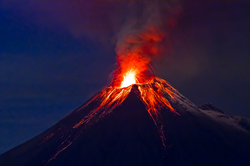¿Regional framework for geothermal projects?
Tuesday, May 28, 2013

Central America forms part of the "Ring of Fire" that surrounds the Pacific Ocean, causing volcanic explosions and earthquakes.
At the same time, volcanic activity usually means the presence of undergrounds streams of molten lava, which generate geothermal energy, a resource with many advantages over the alternatives.
Since the process uses steam from the earth’s core, it doesn’t pollute.
Unlike hydro plants, which don’t work in dry seasons, and unlike wind turbines, which are useless unless the wind blows, geothermal energy is constant.
The region has a potential of at least 5,000 megawatts of geothermal power, according to the German aid agency GTZ.
This would be more than a fifth of the current total demand for electricity.
For now, there has not been much investment in geothermal production.
Polaris Energy, a United States-based company, is currently developing a 72 MW geothermal project in Nicaragua.
Costa Rica and El Salvador have geothermal operations.
More investment would be attracted to the region, if there were greater uniformity in the rules governing this type of production, according to a recent study by the University of Rejkjavik, in Iceland, a leading generator of geothermal energy.
While running a geothermal project is not expensive, it can cost a lot of money to drill shafts in search of steam sources, sometimes located as much as 5,000 meters underground.
In Central America, investors face not only technical challenges, but also different regulatory regimes, which increases the cost of doing business.
A harmonized set of rules would let producers operate regionally on a more efficient basis, attracting investment, while cutting energy costs and pollution.
